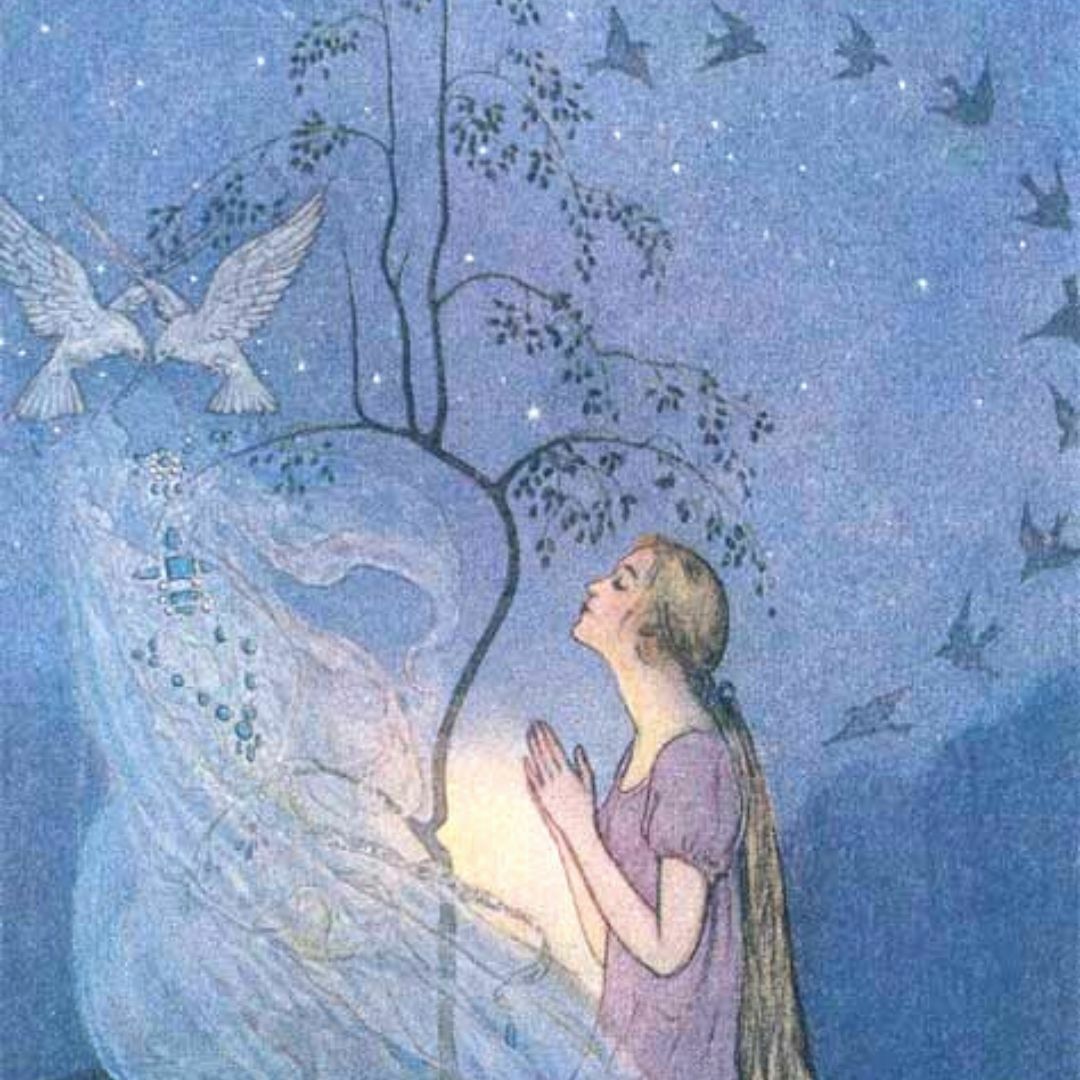
Illustration by Elenore Abbott, 1920
{Image description: Illustration in shades of blue. Cinderella is kneeled down by a thin tree and prays. She has very long blond hair and wears a very simple violet house dress. In front of her a very bright light is shining. On the top left two white doves hold a almost invisible ball gown. In the sky there are some stars and the shadow of some birds making half a circle between the girl and the tree.}
*
The humble, self-sacrificing girl who fulfills all her tasks with dedication and zeal and in the end becomes the most beautiful princess is the perfect tale to illustrate the energy of Virgo, the sign of service, modesty, hygiene, and refinement. This story is so popular that it has versions, adaptations and variants in every media we can imagine, from the various oral and literary narratives, going through theater and film, to opera and ballet.
Charles Perrault's version, published in 1697 in the book Stories of Mother Goose, is probably the most widely known version to this date. However, the story published by Brothers Grimm in 1812, in the first edition of their well-known book of tales, is much richer in detail and I believe closer to the traditional imagery.
In this version by the Grimm brothers, the young protagonist becomes motherless early in the story and her father doesn't take long to remarry. The new family, the stepmother and her two daughters, instead of welcoming the girl, belittle her and reduce her to a servant in her own home.
Virgo is an Earth sign, practical and focused on what is concrete and real. Unlike the previous sign, Leo, people with strong Virgo energy in their birth charts are reserved, humble, and they want to be useful and helpful. They feel good behind the scenes, and they like to know their role in the grand scheme of things. On its shadow side, this sign tends to feel like a victim of circumstances, without power or will of its own, a slave to a situation they believe they can't control, like the young woman in this tale.
Confined to the kitchen, where she doesn't even have a bed to lie on, the girl is forced to sleep in the chimney to keep warm, and for this reason, and to diminish her even further, her sisters call her Cinderella (cinder girl). Just as humility is one of Virgo's best qualities, criticism and humiliation represent their negative side. However, Cinderella (the protagonist's name in Perrault's version) does not complain or make demands, and just like the sign of Virgo, she obediently accepts her fate.
On the grave of her mother, the girl plants a tree that she waters with her tears, such is her suffering. The tree grows, and three times a day Cinderella goes there to cry and pray, fulfilling, even if unconsciously, an emotional and spiritual cleansing ritual, releasing this way her pain and frustration. Every time she does this, a white bird appears, and whenever Cinderella asks for something, the bird grants her the wish.
From this we can gather that the girl's dreams are modest and not at all ambitious, or she would have already freed herself from her bondage. Moderation and caution are also very Virgoan traits, but, taken too far, these can translate as lack of confidence in oneself and believing that one deserves no more than what one has.
One day the king announces a great feast lasting three days, at which the prince would choose his bride. Cinderella's sisters soon begin with the preparations, and the poor girl is forced to help them, knowing that she herself won't be able to go to the palace. Here, for the first time in the tale, Cinderella's aspiration is revealed to us, to go to the ball and live her dream of perfection. But she is not perfect, she doesn't have the right clothes, nor can she dance, and her stepmother forbids her to go to the party, because it would embarrass her and her daughters.
At Cinderella's insistence, the stepmother throws a plate full of lentils into the ashes of the fireplace and tells her that if she can pick the lentils in two hours, she can go to the ball. Cinderella goes to the garden and calls the dove and all the other birds to help her. The birds begin pecking grain by grain and collect all the lentils in less than an hour.
The condition that the stepmother imposes on Cinderella is a rather Virgoan task. To separate the lentils from the ashes, that is to say to separate the wheat from the chaff, it's necessary to use the qualities of discrimination and attention to detail, so typical of this sign, as well as the ability not to be discouraged when faced with work that seems repetitive and monotonous.
Virgo also belongs to the mutable mode and can efficiently adapt to any function it needs to perform, knowing how to choose the most appropriate tool and method. Mercury, the planet of mental processes, is the ruler of this intelligent and rational sign and helps us with analysing, sorting and separating, working towards the improvement and purification of matter.
After the task is accomplished, the stepmother, determined to keep Cinderella from going to the ball, repeats the challenge, but making it twice as hard this time. Once again the job is competently executed with the help of her winged friends.
Birds are a constant presence in the various versions of this tale, but it is also common to find mice, lizards and, in Walt Disney's version, even a dog and a cat. In times not so remote, domestic animals had specific functions in the household and were a great help, whether as food suppliers, as guards against intruders, or as rat catchers. In the birth chart they are included in the symbolism of the 6th house, the house that has affinity with the sign of Virgo.
Still, the stepmother doesn't allow the girl to go to the ball. Although humble and obedient, this sign is also determined, and as soon as everyone leaves, Cinderella goes to the tree, where the bird gives her a beautiful dress, all in silver, and silk and silver shoes. She quickly changes and goes to the party. Throughout the night the prince doesn't dance with anyone else, until Cinderella wants to go home. The prince insists on accompanying her because he wants to know where she lives and who she is, but when she gets to there, the girl runs away and hides. The next night the same thing happens.
On the third night, while running away, the young girl loses one of her little shoes, this time made of the purest gold, on the palace stairs. Virgo is methodical and perfectionist, cautious and prudent, and rarely takes risks, too afraid of making a wrong move and failing. In fact, Cinderella, despite her silver dresses and gold shoes, believes that she will always be the humble and dirty cinder girl, and prefers not to have expectations that she believes to be unrealistic.
This sign is by nature distrustful and insecure, and its level of self-criticism is such that it is often hard for them to believe that they can be loved, despite all their faults, or, even more implausible, that someone can love their imperfections.
Virgo is also discreet and airtight, and this separation between two worlds is no stranger to these natives, who often keep their private lives quite separate from their social or professional ones. However, she leaves behind the shoe, as if to establish a link between her two lives so that they can meet and she can become one again.
The prince goes to Cinderella's family home with the only clue he has, her slipper. First, his older sister tries it on, but since her big toe doesn't fit, on her mother's advice, she cuts it off. Once she can fit her mutilated foot into the shoe, she leaves with the prince to become his wife. The bird, Cinderella's loyal helper, warns the king's son of this deception and he turns back, complaining that this isn't his true bride. Then comes the second sister who, to put on the delicate shoe, is forced to cut off her heel. Again the prince, warned by the bird, turns back to return the false bride.
These self-mutilations remind me of a less healthy side of Virgo, the relentless pursuit of unattainable perfection. This quest can become so extreme that some people become obsessive about their image, taking control over their bodies very aggressively, through diets and weight loss regimes or cosmetic interventions and surgeries. An example of this is the Virgoan Michael Jackson.
When the prince asks Cinderella's father if there are no other young ladies in the house, he replies, "There is only poor little Cinderella, my first wife's daughter. But she can't be the bride..." The end of the story is known, the little shoe fits the girl's foot like a glove, and she and her beloved live happily ever after.
Despite the skepticism of the father, who symbolizes authority and social conditioning, our conscience, the Sun, represented by the Prince, knows how to recognize Cinderella's brilliance and essence, even when she is covered in ashes, that is, even behind all her flaws and all her imperfections.
Through this tale, the sign of Virgo teaches us that the path to perfection is not made by looking towards the finish line or with the expectation of winning the prize of ultimate happiness when we are beautiful, flawless or immaculate. Perfection is a routine and a habit. Perfection is being useful and serving something greater than ourselves. Perfection is achieved every day, whenever we put all our dedication and all our love into every step we take, into every task of everyday life, and into every detail of our lives.
*
2014
